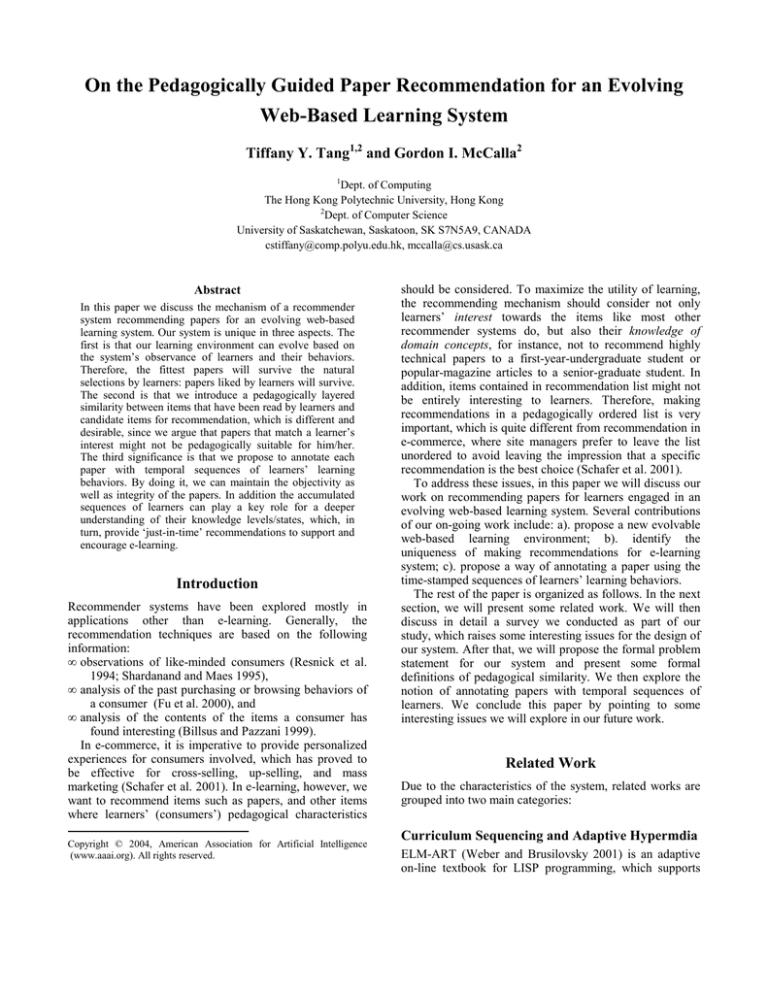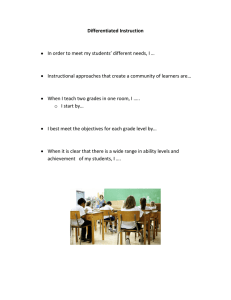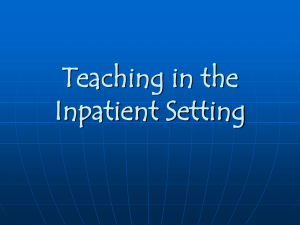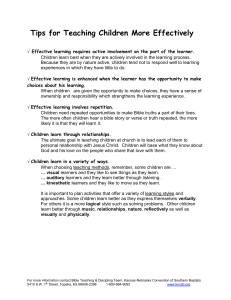
On the Pedagogically Guided Paper Recommendation for an Evolving
Web-Based Learning System
Tiffany Y. Tang1,2 and Gordon I. McCalla2
1
Dept. of Computing
The Hong Kong Polytechnic University, Hong Kong
2
Dept. of Computer Science
University of Saskatchewan, Saskatoon, SK S7N5A9, CANADA
cstiffany@comp.polyu.edu.hk, mccalla@cs.usask.ca
Abstract
In this paper we discuss the mechanism of a recommender
system recommending papers for an evolving web-based
learning system. Our system is unique in three aspects. The
first is that our learning environment can evolve based on
the system’s observance of learners and their behaviors.
Therefore, the fittest papers will survive the natural
selections by learners: papers liked by learners will survive.
The second is that we introduce a pedagogically layered
similarity between items that have been read by learners and
candidate items for recommendation, which is different and
desirable, since we argue that papers that match a learner’s
interest might not be pedagogically suitable for him/her.
The third significance is that we propose to annotate each
paper with temporal sequences of learners’ learning
behaviors. By doing it, we can maintain the objectivity as
well as integrity of the papers. In addition the accumulated
sequences of learners can play a key role for a deeper
understanding of their knowledge levels/states, which, in
turn, provide ‘just-in-time’ recommendations to support and
encourage e-learning.
Introduction
Recommender systems have been explored mostly in
applications other than e-learning. Generally, the
recommendation techniques are based on the following
information:
• observations of like-minded consumers (Resnick et al.
1994; Shardanand and Maes 1995),
• analysis of the past purchasing or browsing behaviors of
a consumer (Fu et al. 2000), and
• analysis of the contents of the items a consumer has
found interesting (Billsus and Pazzani 1999).
In e-commerce, it is imperative to provide personalized
experiences for consumers involved, which has proved to
be effective for cross-selling, up-selling, and mass
marketing (Schafer et al. 2001). In e-learning, however, we
want to recommend items such as papers, and other items
where learners’ (consumers’) pedagogical characteristics
Copyright © 2004, American Association for Artificial Intelligence
(www.aaai.org). All rights reserved.
should be considered. To maximize the utility of learning,
the recommending mechanism should consider not only
learners’ interest towards the items like most other
recommender systems do, but also their knowledge of
domain concepts, for instance, not to recommend highly
technical papers to a first-year-undergraduate student or
popular-magazine articles to a senior-graduate student. In
addition, items contained in recommendation list might not
be entirely interesting to learners. Therefore, making
recommendations in a pedagogically ordered list is very
important, which is quite different from recommendation in
e-commerce, where site managers prefer to leave the list
unordered to avoid leaving the impression that a specific
recommendation is the best choice (Schafer et al. 2001).
To address these issues, in this paper we will discuss our
work on recommending papers for learners engaged in an
evolving web-based learning system. Several contributions
of our on-going work include: a). propose a new evolvable
web-based learning environment; b). identify the
uniqueness of making recommendations for e-learning
system; c). propose a way of annotating a paper using the
time-stamped sequences of learners’ learning behaviors.
The rest of the paper is organized as follows. In the next
section, we will present some related work. We will then
discuss in detail a survey we conducted as part of our
study, which raises some interesting issues for the design of
our system. After that, we will propose the formal problem
statement for our system and present some formal
definitions of pedagogical similarity. We then explore the
notion of annotating papers with temporal sequences of
learners. We conclude this paper by pointing to some
interesting issues we will explore in our future work.
Related Work
Due to the characteristics of the system, related works are
grouped into two main categories:
Curriculum Sequencing and Adaptive Hypermdia
ELM-ART (Weber and Brusilovsky 2001) is an adaptive
on-line textbook for LISP programming, which supports
several key features such as adaptive navigation,
curriculum sequencing, and personalized diagnosis of
student solutions for learners with different prior
knowledge. In order to assess individual learners’ skills and
progress, a series of tests and exercises are used to trace
learner knowledge during the learning process. (Stern and
Woolf 1998) is another similar study. In contrast to the
model tracing approach in ELM-ART, (Tang and Chan
2002) use both active assessment (tests, exercises, and
questionnaire) and passive assessment (learners’ browsing
behavior) to construct the learner model. In addition, as far
as we know, the majority of current web-based learning
systems are adaptive e-learning system where the delivery
of learning item is personalized while the items inside the
system are a priori determined by the system
designer/tutor. In our open evolving e-learning system,
learning items are automatically found on the web and
integrated into the system based on users' interactions with
the system. Therefore, the fittest papers survive. Figure 1
compares the differences with respect to these two types of
e-learning systems.
paper, however, but rather how to recommend additional
references for a target research paper. In the context of an
e-learning system, we believe that additional readings
cannot be recommended purely through an analysis of the
citation matrix of a target paper. Indeed in some cases
pedagogically valuable papers might not be interesting and
papers with significant influence on the research
community might not be pedagogically suitable for
learners. Therefore, we cannot simply present all highly
relevant papers to learners; instead, in order to prevent
them from being frustrated, a recommending mechanism is
adopted to stimulate their motivation to read through those
papers.
In this paper, we will not consider the issue of finding
related papers using various citation techniques described
in []; instead, we assume that a well-selected collection of
papers is maintained by the system. In order to keep up
with the most up-to-date research on the subject, the system
carries a paper-updating mechanism powered by an
imbedded web crawler, responsible for accommodating
new papers and removing some older papers (Tang and
McCalla 2003).
Recommending Technical Papers
There are several related works concerning tracking and
recommending technical papers. Basu et al. (2001) define
the paper recommendation problem as: “Given a
representation of my interests, find me relevant papers.”
They studied this issue in the context of assigning
conference paper submissions to reviewing committee
Learner
model
Adaptive E-Learning
System (static learning
items)
personalized
items
(a) Adaptive e-learning
A Survey
Research on recommender systems for adaptive web-based
environments has proliferated due to the information
overload on the Internet. Unfortunately, research on
recommending learning items to e-learners has been largely
Learner
model
The web
usage/rating
Evolving E-Learning System
(evolving learning items)
personalized
items
(b) Evolving e-learning
Figure 1. Adaptive e-learning system versus evolving e-learning system
members. Bollacker et al. (1999) refine CiteSeer, NEC’s
digital library for scientific literature, through an automatic
personalized paper tracking module which retrieves each
user’s interests from well-maintained heterogeneous user
profiles. (Woodruff et al. 2000) discuss an enhanced digital
book with a spreading-activation-geared mechanism to
make customized recommendations for readers with
different types of background and knowledge. (McNee et
al.2002) investigate the adoption of collaborative filtering
techniques to recommend papers for researchers; the paper
did not address the issue of how to recommend a research
ignored. To make matters worse, as we discussed
previously, making recommendations in the context of an
e-learning system can be strikingly different from that for
e-commerce. The main goal of recommending items is to
provide learners with necessary knowledge of a given topic
and personalize the learning environment which motivates
them to explore more. This is a goal of learner-centered
education (Soloway et al.,1994).
We carried out a survey in order to understand what
average learners actually want from the system, we sent a
questionnaire to 28 people and received 26 responses.
Among the respondents (graduate students or alumni from
computer science and engineering departments), 92% have
more than a year fulltime working experience; 65% are
graduate students; 15% are active researchers in their area;
19% have experiences as either tutors or lecturers; and
more than 35% already had their master degree. The results
can be regarded as the basis of our design. A learning
scenario is introduced in the questionnaire: “Assume that
you are taking a graduate-level class where you need to
read several papers (as what we usually did). For each
topic taught in the class, you are required to read 2 or
repetitively, which indicates their enthusiasm to explore in
breadth. And most of them prefer up-to-dated works (84%)
rather than earlier versions (16%). Respondents who prefer
to compare earlier-version work believe that earlier-version
work is less completed thus easier to read (even though we
explicitly state in the question that both earlier and laterversions have similar technical level). But they will read
the up-to-date version as well if they found the topic
interesting enough to pursue.
69% of respondents prefer to read an interesting but
unimportant paper before they proceed to read an important
Figure 2. Result of the survey
more items (journal paper, workshop paper, etc.)
recommended by the professor or your classmates.” Then,
10 questions are asked which can be categorized into three
groups, i.e. learner preferences about different items,
contents, and delivery methods. The results of the survey
are tabulated into four diagrams shown in figure 2. The two
left-side diagrams of figure 2 show the learners’
preferences over different items. The upper-left diagram
shows the results if the learner is interested in the topic
being taught, while the lower-left diagram shows the results
if the learner is not interested in the topic. The vertical axis
represents the number of respondents. And the solid
/shading bar represents the number of respondents
like/dislike most on the type of item shown below the
horizontal axis. The results show that magazine articles are
the least popular items for learners who are interested in the
topic being taught. Moreover, most of them avoid reading
journal papers if they are not interested in the topic, and
they rely heavily on lecture notes as shown in the lower-left
diagram.
The upper-right diagram shows learners’ preferences
over the presentation of the paper. The results show that
most learners prefer graphical representations, and dislike
papers with formal models or algorithms only. And most of
them prefer papers by well-known authors (92%), from
reputable conference (96%), and with up-to-dated results or
latest version (92%) as shown in the first three bars of the
lower-right diagram. On the delivery issue, all respondents
prefer to know more about various approaches to solving a
similar problem rather than to learn a single approach
but uninteresting one. However, 80% of respondents are
still willing to eventually read that important, yet
uninteresting, paper. This finding substantiates our
previous claims that uninteresting, yet pedagogically
valuable papers should be recommended. These
pedagogically useful, yet uninteresting papers (items) are
not false positives (Sarwar et al., 2000), because they could
be helpful in one way or another to fulfill learners’ learning
expectations. But strategically recommend item becomes
very important as shown that 69% of them prefer to read
unimportant yet interesting paper before read uninteresting
one. Moreover, the ratio of learners who prefer deep review
paper(s) (with many technical aspects) to shallow review
paper(s) (with many interesting presentations/application
descriptions) is 50:50. At least three respondents (12%)
said that they are willing to read both papers if they are
interested in the topic being reviewed and two of them
stated that they would skim the shallow review paper first
before going deep into the other one. At last, when they are
recommended to follow a rich research resources link
maintained by well-known researchers or research groups,
50% of respondents prefer the recommender system to
provide more specific information rather than search by
themselves from it. A solution to this problem is to provide
additional annotations so as to keep the recommendation to
be more personalized and specific.
From the above analysis, it is obvious that personalized
recommendation is very important in order to
accommodate learner needs, knowledge levels and
expectations. And the delivery of recommendations serves
to keep learners engaged and motivated. In the next section
we will present a detailed description of our approach and
also introduce some important definitions for our proposed
approach.
Our Approach: Pedagogy-Oriented Paper
Recommendation
Problem Statement
Thus, we get RC = ∩j∈LRIj and R = Uj∈LRIj. Additional item
beyond R is unnecessary. However, deciding RI is a nontrivial task, because in an ideal case, the tutor needs to
decide proper pedagogical criteria in recommending the
item. This issue is beyond the scope of this paper, so we
continue with the definition of similarity between two items
in the following part.
Definition 4. Similarity of two items r1 and r2 ∈ R.
1. v-similarity (version-based): r1 and r2 share the same
topic, might be written by same authors, but one is a
refined/updated version of another.
Our goal is the following:
Given a collection of items and a learner’s profile,
recommend and deliver a set of items in a pedagogically
appropriate sequence, so as to meet both the learner’s
pedagogical needs and interest.
2. c-similarity (comparison-based): r1 and r2 discuss the
same topic, with different approach.
To be precise, items include any online item which can
help learners understand the topic being taught, such as
technical papers, review papers, book chapters, magazine
articles, abstracts, white papers, presentation slides, and
tutorial notes. In our current research, we will not include
presentation slides and tutorial notes.
4. s-similarity (simplicity-based): r1 and r2 concern the
same topic and have the same level of simplicity in
order to be understood.
A Formal Notation of Paper Recommendations. For a
learner model U, find a group of similar learners, N(U).
Given content C, find a group of relevant papers P(C).
Find a subset of learners N’ ⊆ N(U), who have read/rated
any paper in P(C); denoted by f: N(U) × P(C) → N’.
Based on the ratings given by N’, use collaborative filtering
to find a set of recommended papers P’⊆ P(C). In the
following section, we are going to introduce the notion of
pedagogically
layered
similarity
for
paper
recommendations.
Basic Model of Recommendation in E-learning
3. t-similarity (technique-based): r1 and r2 use the same
technique to solve two different problems.
Definition 5. Ordering of a set of item RS, where RS ⊆ R
and |RS| > 1.
1. t-order: sequence of RS according to their technical
difficulty.
2. l-order: sequence of RS according to their length.
3. p-order: sequence of RS according to the abstraction of
their presentation.
4. r-order: sequence of RS according to the prestige of
their publications.
5. c-order: sequence of RS according to the chronology of
their publications.
6. d-order: sequence of RS according to their pedagogical
value.
We present a model of our recommendation system starting
with some basic definitions.
Before we define some concepts of the delivery of
recommended item, we will define curriculum DAG and
recommendation mapping as follows:
Definition 1. A item in the domain being learned, denoted
by r, is called commonly well selected if it is pedagogically
suitable for all learners L under common learning
constraints (time, prior knowledge, availability, etc.). The
same definition applies for a set of all item, denoted by RC ,
i.e. it is commonly well selected if all items r∈RC is
commonly well selected.
Definition 6. The curriculum DAG (directed acyclic graph)
is a weighted DAG with its nodes representing learning
items and its link/arcs representing the ‘prerequisite’
relationship, e.g. the source node(s) are the prerequisite
item for the destination node (target item). The weight
represents the importance of corresponding prerequisite
item in understanding target item.
Definition 2. An item in the domain being learned is
individually well selected if it is pedagogically suitable for
a specific learner j∈L, under his/her individual learning
constraints (common learning constraints plus individual
learner characteristics, such as learning style, prior
knowledge, preference, etc.). The same definition applies
for all individually well selected item, denoted by RI, i.e. it
is individually well selected if all items r∈RI is individually
well selected.
Generally, a curriculum DAG can be formalized as a
tuple <Q, W, S> where Q is the set of nodes, W is the
adjacency matrix representing the weight and direction of
links/arcs connecting pair of nodes, S represents the label
matrix of logical relation (AND/OR) among nodes as the
pre-requisite of other node. An example of curriculum
DAG is the AND/OR graph (McCalla 1992).
Definition 3. The set of all individually well selected items
is called the aggregate well selected item, denoted by R.
Definition 7. Recommendation-Curriculum mapping (R-C
mapping) is a mapping of R to each node in the curriculum
DAG under following constraints:
1. learners can (to some degree) understand the item in R
if they already understand the item covered in the node
and/or some/all prerequisite node(s) given they possess
some prior (basic) knowledge before they learn;
2. the learning item is useful to help learner understand a
topic or motivate learner to learn more.
Formally, for each node q in curriculum DAG, the result
of R-C mapping is the candidate set Rq = {rq | rq∈R and rq
⊕ q > T and (∀k∈rq) k∈p0∪q∪q-}, where Rq ⊆ R is all
items stemmed from node q, ⊕ is a binary relation
R×Q→ℝ+ representing the degree of usefulness to know rq
after learning q, T is a threshold set by designer/tutor, k is a
core knowledge contained in rq which is crucial to
understand rq, p0 is the estimation of learners’ prior
knowledge and q- is the set of prerequisite nodes of q. The
selection process mainly follows the tutor’s subjective
beliefs, because tutors may not know precisely learners’
tutors
recommendation arcs/links, representing the relationship
between these items in a candidate set, are based on the
similarity measurement and ordering defined in definition 4
and definition 5. Since there are different orderings and
similarity criteria, the arcs will have various weights and
the DAG (Rq) can be represented as <Rq, W1, W2, …, Wn,
Fq> where Rq is the set of nodes (candidate set), Wi is the
adjacency matrix representing the weight and the direction
of arcs connecting pairs of nodes based on criterion i, and
Fq is the adjacency matrix representing the frequency of a
link accessed by learners.
Now we are ready with the last definitions of delivery
sequence and the sequencing procedure, i.e. how to select
an item from each candidate set.
Definition 8. The delivery sequence of item, SD, is the
sequence of item recommended to the learner, i.e. the
partial topological order of DAG(Rq), according to
learners
User ID: 2771
Time : 02/04/03 09:27
Annotating Module
Papers and their annotations
Paper
Paper
Description
Description
1.
2.
3.
UserID:
Time:UserID:
Rating
Time:UserID:
Description
Rating
Time:
Rating
Description
Description
1.
…..
2.
….
Paper ID:
Paper ID:
034
……
….
….
Difficulty
Clarity
Importance
Interestingness
Overall rating:
high
good
high
low
4
Pedagogical-purposed info.
DB4
Clusters of
learners with
similar goals,
ratings, etc.
DB3
Cluster of paper
usages, for novice
learners, experts, etc.
Intelligent Data Processor
(data miner, recommender system)
Cluster of learners
behaviors, reading
patterns, etc.
DB1
DB2
Design-purposed info.
Clusters of papers
with similar reading
patterns, ratings, etc
Figure 3. Annotating paper with sequence of learner models
exact prior knowledge at the time they are visiting node q,
or tutors have different criteria deciding which item should
be recommended. Moreover, the mapping must be
complete, i.e. for all r∈R there are node(s) q∈Q such that
r∈Rq; otherwise we waste recommendation resources R.
Furthermore, the same item can be put into more than one
candidate set. All ellipse nodes and their directed links/arcs
constitute a curriculum DAG. And the set of all nodes in a
small DAG (consisting of small black nodes) stemmed
from each ellipse node is the candidate set. For instance,
there are four item in candidate set Rq5, which means that
after a learner learns the topic in q5 the system will
recommend up to four additional items. The
observed learner characteristics, with the aim of
maximizing the estimated utility of learning.
Definition 9. The sequencing procedure of item, Σ, is the
procedure to produce SD from Rq and learner model ML.
Annotating Papers with Temporal Sequences
of Learner Models
It is obvious that as more and more learners have read and
rated a paper, the number of user ratings with respect to the
paper will be accumulated. These accumulated sequences
of learner models reflected the temporal pedagogical
knowledge state at the time when the learners accessed the
paper. Figure 3 illustrates our idea of annotating papers
with sequences of users.
The “Conflict of Understanding and Interest”
Problem
For paper p, and user U, we might have the following
learner sequences Ui t, where t is the time when the user
accessed the paper. Therefore, when a user reads a paper at
different time, he/she might have different ratings toward it,
i.e. his/her understanding towards the paper might change
(either to the better or to the worse), due to his/her own
increasing background knowledge on the subject. This will
also lead to a so-called “conflict of understanding and
interest” problem where a user might provide largely
different ratings towards a paper. But from both learners’
and tutors’ perspective, this phenomena is natural given the
increasing pedagogical ability of learners as time goes by,
therefore, we will not make effort to “solve” this conflict;
instead, these traces of living conflicts will be explored
later to make a deep understanding of both the usage of a
paper, and the learning curve of a learner.
It is obvious that as we can cluster users purely based on
their browsing behaviors, we can also cluster the annotated
user models with respect to a specific paper, or sequences
of papers. Technically, the sequences of user models along
with the collections of paper will provide rich information
related to both users, user patterns, papers and paper usage
patterns, which, in turn, can make more refined
recommendations, provide both personalized and
groupalized recommendations and form dynamic and
collaborative groups based on clusters of learners with
different interests, pedagogical backgrounds (Tang and
Chan 2002).
Conclusions
In this paper we discuss the mechanism of a recommender
system recommending papers for an evolving web-based
learning system. Our system is unique in three aspects. The
first is that it is evolvable, with the fittest papers survive.
The second is that we introduce a pedagogically layered
similarity between items read by learners and candidate
items for recommendation. Finally, we propose to annotate
each paper with temporal sequences of learners’ learning
behaviors. Currently, we are simulating artificial learners as
a first step towards a deeper understanding of how the
system works.
Acknowledgments. We would like to thank Canadian
NSERC for the financial support.
References
Basu, C., Hirsh, H., Cohen, W. and Nevill-Manning, C. 2001.
Technical paper recommendations: a study in combining multiple
information sources. JAIR 1, 231-252.
Billsus, D.and Pazzani, M. 1999. A hybrid user model for news
story classification, In UM’99.
Bollacker, K., Lawrence, S. and C. Lee Giles, C. L. 1999. A
system for automatic personalized tracking of scientific literature
on the web. In ACM DL, 105-113.
Fu, X., Buzdik, J. and Hammond, K.J. 2000. Mining navigation
history for recommendation. In ACM IUI’2000, 106-112.
McCalla G. 1992. The search for adaptability, flexibility and
individualization: approaches to curriculum in intelligent tutoring
systems. Adaptive Learning Environments. NATO ASI Series,
vol. F.85. Springer-Verlag. 91-121.
McNee, S, Albert, I., Cosley, D., Gopalkrishnan, P., Lam, S.,
Rashid, A., Konstan, J. and Riedl, J. 2002. On the
Recommending of Citations for Research Papers. ACM
CSCW’02. 116-125.
Pitkow, P., Schutze, H., Cass, T., Cooley, R. Turnbull, D.,
Edmonds, A., Adar, E. and Breuel, T. 2002. Personalized Search.
Communications of the ACM, 45 (9): 50-55, Sept.
Resnick, P., Iacouvou, N., Suchak, M., Bergstrom, P. and Riedl,
J. 1994. GroupLens: an open architecture for collaborative
filtering of Netnews. In ACM CSCW’94, Chapel Hill. 175-186.
Sarwar, B., Karypis, G., Konstan, J. and Riedl, J. 2000. Analysis
of recommendation algorithms for e-commerce. In Proc. ACM
EC’2000, 158-167.
Schafer, J., Konstan, J. and Riedl, J. 2001. Electronic Commerce
Recommender Applications. Data Mining and Knowledge
Discovery, 5, (1/2, 2001), 115-152.
Shardanand, U., and Maes, P. 1995. Social information filtering:
algorithms for automating ‘word of mouth’. In ACM CHI’1995,
210-217. Denver.
Soloway, E., Guzdial, M., and Hay, K. 1994. Learner-centered
design: the challenge for HCI in the 21st century. ACM
Interactions, 1(2): 36-48, April.
Stern, M and Woolf, B. 1998. Curriculum Sequencing in a Webbased Tutor. In ITS 98. 574-583.
Tang, T.Y., and Chan, K.C.C. 2002. Feature construction for
student group forming based on their browsing behaviors in an elearning system. In PRICAI 2002. Springer LNCS 2417. 512-521.
Tang, T.Y and McCalla, G. 2003. Smart recommendations for an
evolving e-learning system. In Workshop on Technologies for
Electronic Documents for Supporting Learning, AIED'2003,. July
Sydney, Australia. 2003.
Weber, G.,and Brusilovsky, P. 2001. ELM-ART: an adaptive
versatile system for web-based instruction. International Journal
of AI in Education. 12: 1-35.
Woodruff, A., Gossweiler, R., Pitkow, J., Chi, E. and Card, S.
2000. Enhancing a digital book with a reading recommender. In
ACM CHI 2000.153-160.






